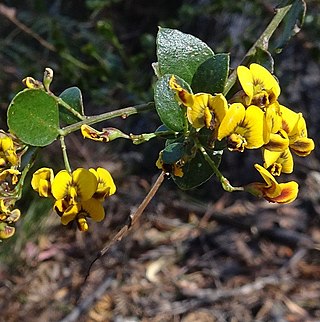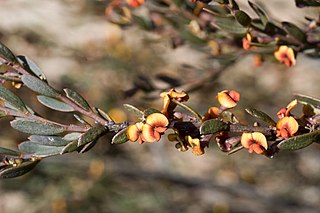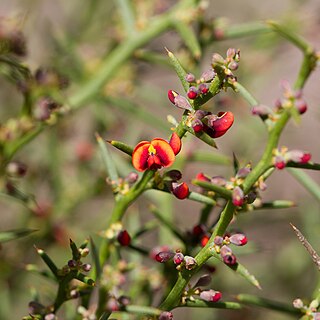
Daviesia ulicifolia, commonly known as gorse bitter-pea, is a species of flowering plant in the family Fabaceae and is endemic to south-eastern Australia. It is a rigid, openly-branched shrub with sharply-pointed, narrow elliptic, narrow egg-shaped, rarely egg-shaped phyllodes and usually orange-yellow and dark red flowers.

Daviesia leptophylla, commonly known as narrow-leaf bitter-pea or slender bitter pea, is a species of flowering plant in the family Fabaceae and is endemic to south-eastern continental Australia. It is a broom-like, multi-stemmed shrub with dull, yellowish-green, linear phyllodes and bright yellow flowers with maroon markings.

Daviesia buxifolia, commonly known as box-leaf bitter-pea, is a species of flowering plant in the family Fabaceae and is endemic to south-eastern continental Australia. It is an open shrub with egg-shaped to round phyllodes and yellow or yellowish-orange and maroon-brown flowers.

Daviesia mimosoides, commonly known as blunt-leaf bitter-pea, narrow-leaf bitter pea or leafy bitter-pea, is a species of flowering plant in the family Fabaceae and is endemic to eastern continental Australia. It is an open shrub with tapering, linear, elliptic or egg-shaped phyllodes, and groups of orange-yellow and dark brownish-red to maroon flowers.

Daviesia umbellulata is a species of flowering plant in the family Fabaceae and is endemic to eastern Australia. It is a slender shrub with egg-shaped or linear phyllodes, and groups of up to six yellow to orange flowers with maroon markings.

Daviesia arenaria, commonly known as sandhill bitter-pea, is a species of flowering plant in the family Fabaceae and is endemic to south-eastern continental Australia. It is usually a hummock-forming shrub with many short, spiny branchlets and heart-shaped to elliptic phyllodes with a sharp point on the end, and orange-pink, maroon and yellow flowers.

Daviesia argillacea is a species of flowering plant in the family Fabaceae and is endemic to the south-west of Western Australia. It is an erect, bushy shrub with erect narrow egg-shaped phyllodes with the narrower end towards the base, and yellow to orange and maroon flowers.

Daviesia devito is a species of flowering plant in the family Fabaceae, endemic to south-eastern continental Australia. It is a dense, prickly shrub with sharply-pointed phyllodes and yellow, red, greenish and maroon flowers. It was previously known as Daviesia benthamii subsp. humilis until that subspecies was split into two new species.

Daviesia elliptica, commonly known as wild hops, is a species of flowering plant in the family Fabaceae and is endemic to eastern Australia. It is an open, usually multi-stemmed shrub with scattered, narrowly elliptic to egg-shaped phyllodes, and yellow and red to maroon flowers.

Daviesia emarginata is a species of flowering plant in the family Fabaceae and is endemic to the south-west of Western Australia. It is an erect, mostly glabrous shrub with scattered egg-shaped phyllodes with the narrower end towards the base and with a notch at the tip, and yellow and pink flowers.
Daviesia filipes is a species of flowering plant in the family Fabaceae and is endemic to Queensland. It is a shrub with hairy foliage, crowded, narrowly oblong phyllodes, and yellow and maroon flowers.

Daviesia flava is a species of flowering plant in the family Fabaceae and is endemic to Queensland. It is a glabrous shrub with linear or narrowly egg-shaped phyllodes, and uniformly yellow flowers.

Daviesia glossosema, commonly known as maroon-flowered daviesia, is a species of flowering plant in the family Fabaceae and is endemic to a restricted area of south-western Western Australia. It is an erect shrub with tangled, spreading branches, cylindrical, sharply-pointed phyllodes, and unusually-shaped maroon flowers.

Daviesia grahamii is a species of flowering plant in the family Fabaceae and is endemic to the interior of Western Australia. It is a multi-stemmed shrub with narrowly egg-shaped to linear phyllodes, and bright yellow to orange-yellow, dark red and maroon flowers.

Daviesia microphylla is a species of flowering plant in the family Fabaceae and is endemic to the south-west of Western Australia. It is an openly-branched, sprawling shrub with spiny branchlets, crowded, sharply-pointed, egg-shaped phyllodes, and orange, dark red and maroon flowers.

Daviesia oppositifolia, commonly known as rattle-pea, is a species of flowering plant in the family Fabaceae and is endemic to the south-west of Western Australia. It is an erect shrub with many stems, egg-shaped phyllodes with the narrower end towards the base, and yellow flowers with maroon markings.

Daviesia pedunculata is a species of flowering plant in the family Fabaceae and is endemic to south-western Western Australia. It is a spreading or sprawling to erect shrub with erect, egg-shaped to elliptic phyllodes, and yellow and maroon flowers.

Daviesia purpurascens, commonly known as purple-leaved daviesia, is a species of flowering plant in the family Fabaceae and is endemic to the south-west of Western Australia. It is a glabrous shrub with many branchlets, scattered, erect, cylindrical, sharply pointed phyllodes and yellow and maroon flowers.

Daviesia sejugata is a species of flowering plant in the family Fabaceae and is endemic to southern Australia. It is a straggling, mostly glabrous shrub with spiny, ridged branchlets, scattered, sharply-pointed, narrowly elliptic phyllodes, and yellow, maroon, orange and dark purple flowers.

Daviesia trigonophylla is a species of flowering plant in the family Fabaceae and is endemic to the south of Western Australia. It is an erect, bushy shrub with elliptic or egg-shaped phyllodes that are triangular in cross-section, and orange, dark red and maroon flowers.




















